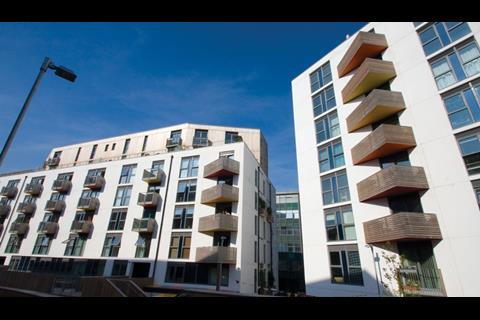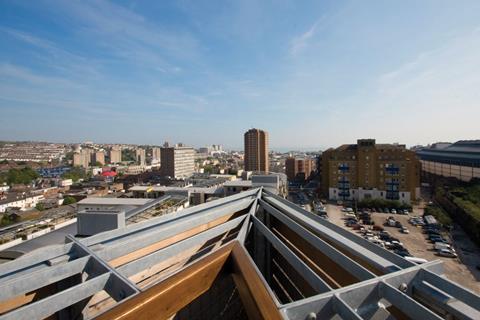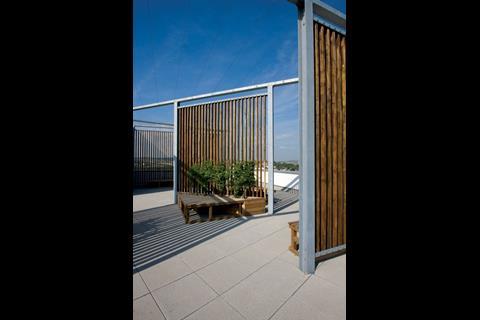One Brighton is the brainchild of the team behind super-green development BedZed. But although sustainability is at the heart of the scheme, itŌĆÖs going to do it its own sweet way
On 7 May, Brighton elected the UKŌĆÖs first ever Green MP. An 8.4% swing from Labour saw Caroline Lucas triumph in the Brighton Pavilion constituency with a majority of 1,252.
But Lucas isnŌĆÖt the only green vote winner in Brighton. A new zero-carbon residential scheme designed by Feilden Clegg Bradley has also won the approval of a large chunk of BrightonŌĆÖs electorate.
Apartments at the 172-unit One Brighton scheme have sold so quickly that developer BioRegional Quintain has instructed contractor Denne to bring forward the completion of the final phase from August to June.
But unlike the MPŌĆÖs campaign, One Brighton doesnŌĆÖt scream green and thereŌĆÖs no equivalent of a party activist shouting eco-credentials through a loud hailer. Potential buyers wonŌĆÖt see wind turbines, photovoltaics or solar panels, just a modern apartment with high kerb appeal and stunning views over Brighton and the South Downs.
In fact, the scheme looks like a regular modern apartment complex, albeit a very refined one. The two blocks - named Brighton Belle and Pullman Haul in honour of nearby Brighton station - range from nine to 11 storeys. Affordable housing makes up 31% of the scheme, with 1,134m2 of offices and 929m2 of community space. The white rendered facade is punctuated by timber balconies and rooftop gardens, and three interconnected courtyards provide more planting area.
One BrightonŌĆÖs low green profile is particularly surprising when you consider that the sustainability charity BioRegional was previously involved in BedZed, the original zero-carbon development in Sutton, London where green technology, such as the colourful wind cowls drawing in fresh air, was designed to make a clear visual statement about green living.
The technology
The mainstream appeal of One Brighton is part of the philosophy of BioRegional QuintainŌĆÖs managing director and co-founder Pete Halsall (see box ║├╔½Ž╚╔·TV a Sustainable Communities Business).
Halsall believes that to make sustainable housing work you need large schemes, which require ŌĆ£developers with big pocketsŌĆØ.
Quintain and Crest, who pumped ┬Ż25m into One Brighton, were never going to invest in a risky project, says Halsall. He believes that making zero-carbon schemes attractive to investors is about using technology thatŌĆÖs not going to throw up unexpected costs (see box Tried and tested technologies).
ŌĆ£I love BedZed dearly, but I didnŌĆÖt think it was replicable. One of the things we learned from it was: donŌĆÖt use anything that hasnŌĆÖt been tried and tested,ŌĆØ says Halsall, who draws attention to the problems BedZed had with a new biomass boiler system which become clogged with tar when wood chips were burnt.
By contrast, this time Halsall specified a Austrian biomass boiler system which had a proven, 20-year track record. ŌĆ£Crest were unsure about using a biomass boiler until I took them to Austria six years ago to see the boilers in operation,ŌĆØ says Halsall.
In many ways, the path from BedZed to One Brighton reflects the way the Code for Sustainable Homes has developed. The first incarnation of the code required all power to be generated on site. In its latest incarnation the code is likely to allow 30% of a schemeŌĆÖs carbon emissions to be mitigated by off-site energy sources. This fits in with HalsallŌĆÖs philosophy and approach to One Brighton. ŌĆ£I want to build sustainably through recognition of interdependence,ŌĆØ he says. ŌĆ£We really do need to rely on others to become sustainable.ŌĆØ
For Halsall, this means buying in off-site renewable energy if itŌĆÖs more cost effective. He is firm that this is the way forward for the industry and splits his sustainability peers into those who accept interdependence and those who are intent on creating all energy ŌĆ£autonomouslyŌĆØ through on-site renewables. ŌĆ£BedZed tried to do it all on site. If you do that, the development becomes unviable,ŌĆØ he warns.
It is a strong message to the new government as Halsall reckons allowing just 30% of a schemeŌĆÖs emissions to be mitigated off site isnŌĆÖt enough. Some 50% of One BrightonŌĆÖs
energy needs are met from off-site sources.
ŌĆ£We donŌĆÖt think the [current definition of zero carbon] arrangements are workable,ŌĆØ he says, ŌĆ£so we havenŌĆÖt invested the time to see how One Brighton compares with that.ŌĆØ
ŌĆ£There is a logic to uncoupling the generation of electrical energy from developments,ŌĆØ says Halsall. ŌĆ£Renewable electrical energy comes from wind farms and thereŌĆÖs not enough wind power to harvest on most schemes. Turbines should be in windy places, connected to the National Grid.ŌĆØ
Halsall says generating heat on site using proven biomass technology makes more sense. ŌĆ£We donŌĆÖt have the urban infrastructure to transport heat and there is the difficulty of heat loss.ŌĆØ (See box Tried and tested technologies.)
Extra reassurance for investors is provided with the inclusion of a backup conventional gas boiler. ŌĆ£We knew Crest were nervous with the biomass so, unsolicited, we said there would be a back-up boiler. It would be silly not to. You might have another cold winter, as in 1963, where you couldnŌĆÖt get lorries on site [delivering wood chips] for three weeks.ŌĆØ
ŌĆ£IŌĆÖm a system engineer so I always look to have a plan B if plan A fails,ŌĆØ says Halsall. ŌĆ£People who think of sustainability autonomously will wonder whether they can have a back-up boiler.ŌĆØ
The people
BioRegional approached One Brighton with a green philosophy, which it aimed to make as user-friendly as possible. The development follows BioRegionalŌĆÖs principles of sustainability (see box 10 principles), which emphasise the user experience as much as the technology used. The architect and developer have paid particular attention to soft infrastructure such as sky gardens and community events, which Halsall believes will encourage residents to be more socially active.
Halsall wanted to recreate the sense of communal space he saw in Spanish apartment courtyards, so punched into the blockŌĆÖs facades are two-storey high slots containing covered gardens. ŌĆ£These sky gardens have blurred the lines between flat and garden living,ŌĆØ he says.
There is also a roof garden and a rooftop allotment with 28 small plots, which adheres to BioRegionalŌĆÖs principle of providing local food. Halsall wanted a restaurant on site providing locally sourced produce, but none were willing to risk trading away from the restaurant strip in the nearby, popular North Laines district. Green caretaker Peter Commane provides a human contact and reminds residents of the eco-benefits they can achieve from their building. He handles food delivery boxes, distributes compost generated from recycled waste and ensures that allotments stay weed free - a polite letter warns residents they will lose their allotments if they let their plots go to seed.
The legacy
Halsall is adamant that a sense of community will continue to thrive once BioRegional Quintain has left the site. He will create a cafe for residents and is hosting communal events. ŌĆ£We are teaching people how to use the spaces and weŌĆÖre going to run a poetry and storytelling event.ŌĆØ No music or barbeques, though. ŌĆ£We want the spaces to be quiet and contemplative.ŌĆØ
More importantly, BioRegional Quintain has put in place an Energy Services Company (ESCO) to manage the energy generation equipment on site and to bulk purchase certified electricity from renewable energy sources. The ESCO will be run for two years at least.
It will also maintain one energy icon that can only be seen from the roof garden - photovoltaic panels. Halsall is almost apologetic about their inclusion. ŌĆ£They donŌĆÖt really do much. ItŌĆÖs really symbolic - just so people know that this is a sustainable building.ŌĆØ Which sums up HalsallŌĆÖs attitude to green building - high on proven technologies and interdependence, low on
go-it-alone green bling.
BioRegionalŌĆÖs 10 principles of sustainabililty
- Zero carbon
- Zero waste
- Sustainable transport
- Sustainable materials
- Local and sustainable food
- Sustainable water
- Natural habitats
- Reviving local culture
- Support for local communities
- Active and sociable living
║├╔½Ž╚╔·TV a sustainable communities business
Pete Halsall was clear what he needed to create a sustainable developer in the UK:
- The backing of a property developer with big pockets
- The involvement of a sustainable charity to give the venture green credentials
- Guiding principles clearly laying out the green objectives.
The principles were particularly important in attracting mainstream investment. Halsall was put off by what he had seen in America, where sustainable communities cut themselves off from ordinary living in their desire to be self-sufficient in food and energy. Halsall believes in being sustainable through interdependence, which means, for instance, buying in renewable energy from off-site sources if it is cheaper.
Halsall succeeded in attracting Quintain to the venture and formed BioRegional Quintain with himself as managing director. The company is 100% owned by Quintain,
but Halsall and co-founder Pooran Desai share profits with the BioRegional charity.
For Quintain, the partnership was an opportunity to learn about the future.
ŌĆ£The company saw there were lessons that could be applied to the rest of their portfolio,ŌĆØ says Halsall. ŌĆ£To be a leader you need scouts who are going over the horizon, bringing back knowledge and experience.ŌĆØ
What the residents say
Ben Crossman, illustrator
ItŌĆÖs nice to see waste thought of in a responsible way. I canŌĆÖt say I use the food waste disposal. ItŌĆÖs a bit smelly and gross. I donŌĆÖt use the allotments, because IŌĆÖve got a huge balcony.
You donŌĆÖt need a car. IŌĆÖve got a bike here that I can store, which is good.
Kelly Clifford, financial controller, property company
ItŌĆÖs fantastic. We were renting, but today weŌĆÖve just had an offer accepted. The caretakers really take care of it. I wanted to engage in recycling initiatives but never got round to it before
I came here. Here it forces you to do it with garbage separation and you adapt quite quickly. It doesnŌĆÖt take long to get used to. Once the weatherŌĆÖs more conducive IŌĆÖll be using the
roof deck. ItŌĆÖs beautiful up there. My partner finds the neighbours really friendly. People are polite.
Daniel Yuen, temporary business visit
I use the waste recycling including bringing the food down here. I like the windows. You donŌĆÖt feel the climatic effects outside. Even during the coldest times itŌĆÖs very warm inside and it doesnŌĆÖt use radiators so it doesnŌĆÖt feel dry. ItŌĆÖs got very good circulation.
Project team
Products
External wall system Natural ║├╔½Ž╚╔·TV Technologies
Timber cladding Finnforest
Windows Swedish Timber Products
Curtain walling Prima Systems
Roofs, planters Bauder
MVHR Applied Energy
Wood Boiler Wood Energy
Photovoltaics Photon Energy
External paving Formpave
Project team
Architect Feilden Clegg Bradley Studios
Main contractor Denne Construction
Structural engineer Scott Wilson
Mechanical and electrical engineer Fulcrum/MLM
Planning consultant Planning Perspectives
Landscape architect Nicholas Pearson Associates
Cost consultant Jones Lang LaSalle
Tried and tested technologies
Biomass boiler
The biomass boiler was specified because it was proven technology, having been used in Austria for 20 years. It originally ran on wood pellets transported from Scotland, but now South East Wood Fuels, a local consortium of landowners, supplies regular deliveries of wood chips.
ŌĆ£We thought it would be easier to commission the boiler on pellets but they have been more problematic than wood chip,ŌĆØ says Halsall. ŌĆ£I believe the fine dust on the machined pellets was forming lumps that were stopping the auger [which channels pellets to the boiler] from working. Because pellets are engineered, they are more dusty.ŌĆØ
The moisture content of wood chip varies through the seasons and, as this is a function of wood chipŌĆÖs calorific value, green caretaker Peter Commane has to check each delivery to see that moisture is within acceptable limits.
Halsall says this is a minor inconvenience and is pleased with the switch to locally sourced wood chip. ŌĆ£Pellets are more expensive, and the calorific value is not much better than wood chip.ŌĆØ
Green concrete
Halsall believes a huge number of sustainable building methods are not reflected in the Code for Sustainable Homes. For example, he thinks the ŌĆ£extremely greenŌĆØ concrete used at One Brighton should be valued as highly as timber frame.
The concrete includes 100% recycled aggregate and 50% cement substitute (ground granulated blast furnace slag). Post-tensioning meant floor slabs could be thinned down to 225mm rather than 300mm. ŌĆ£We used one-third less concrete and itŌĆÖs massively more green than normal,ŌĆØ says Halsall.
Clay walling system
Halsall has used the ThermoPlan clay walling system which has been widely used on the continent, where it is known as Ziegel. It acts as a humidity moderator, says Halsall. Its permeability will let vapour escape and if rooms get very dry it will let moisture back into the air. ŌĆ£Richard Dawkins should look into clay,ŌĆØ jokes Halsall. ŌĆ£How can this natural material be so predisposed to being a building product?ŌĆØ The single leaf interlocking walls system is supplemented by 100mm of Pavatex Woodfibre insulation.
Mechanical ventilation heat recovery
ŌĆ£Why wouldnŌĆÖt you?ŌĆØ says Halsall. Stored hot water heated by the biomass buffer tanks is pumped to consumer interfaces in each flat and heating is provided by pumping the hot water through an Applied Energy MVHR unit, where it warms the air.
Halsall is critical of the UKŌĆÖs traditional approach to domestic heating and ventilating. ŌĆ£We deal with the thermal envelope, then we deal with fresh air and ventilation. Often by drilling holes in high-performance windows.ŌĆØ
For a full list of suppliers, go to
































No comments yet